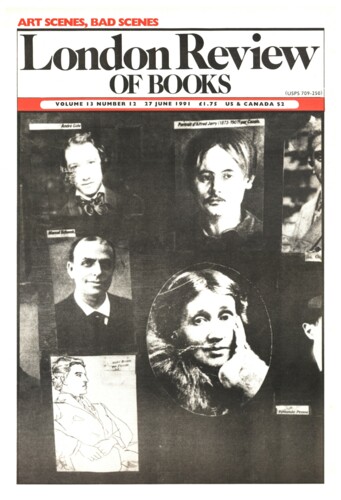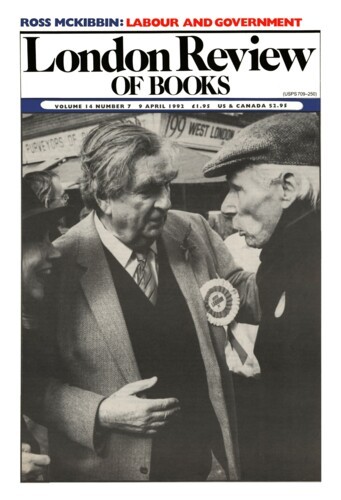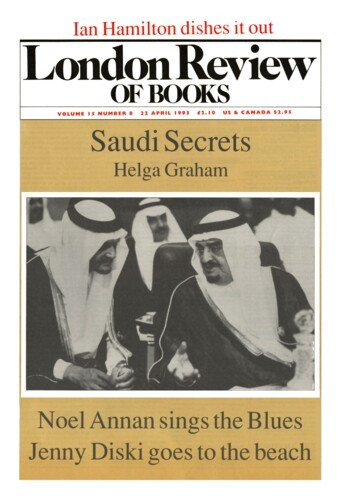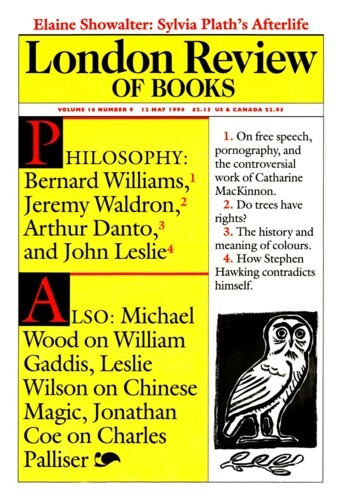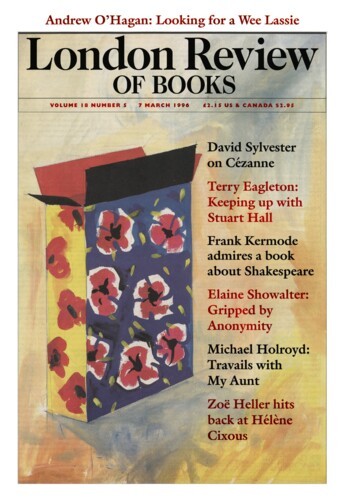Arthur C. Danto
Arthur C. Danto is a professor of philosophy at Columbia and an art critic for the Nation. Beyond the Brillo Box: Art in the Post-Historical Period will be published this year.
In a Forest of Two-Dimensional Bears
Arthur C. Danto, 9 April 1992
Kant’s characteristic philosophical strategy – ingenious, original, and by his own assessment, revolutionary – consisted in transferring to the mind, as among its organising principles, a great many of the features heretofore ascribed to the objective order of the world. Causality, for example, rather than some bonding agency, linking event with event under the laws of nature, was instead a defining structure of the way we organise experience: it would not be experience were it not causally ordered. And space, rather than some vast container in which the furniture of the universe is stowed, is instead a form of perception – an innate a priori scheme through which bodies present themselves to the senses as coordinated. The laws of this mode of organisation arc given by geometry, which Kant had no grounds for believing other than Euclidian; and indeed, well after the advent of non-Euclidian geometries, it was still widely maintained that Euclid’s defines the structure of spatial experience for minds such as ours. Kant was interested in human nature only in the most universal terms, and it was his assumption that our spatial intuitions must be largely invariant inasmuch as we are all built the same. The organising principles of the form-giving mind must be the same from period to period of history, and culturally all of a piece.’
Art’s Infancy
Arthur C. Danto, 22 April 1993
I have always thought of Richard Wollheim as embodying the values and interests of a particularly urbane kind of British intellectual, typified by and possibly originating with the members of the Bloomsbury Circle. It encompasses a serious interest in the arts and especially the art of painting; a dedication to some version of socialist politics; a faith in psychoanalysis as therapy and as a theory of the mind; a commitment to articulate an aesthetic philosophy and in some measure to attempt to live by it; a determination to enhance one’s prose with a certain literary surface; and a profound concern for friendship and the life of the heart. Wollheim would surely have fitted easily and naturally into the world of the Woolfs – affable, witty, curious about others, conversational and charming. He has published a novel, A Family Romance, but his philosophical writings are marked by that kind of sudden ‘turn’ which Forster used to such effect in dealing with the dramatic incidents that change his characters’ lives; and he likes to stop, as we say in the States, on a dime, ending his pieces abruptly, implying an abyss of thought beyond the point where his essay leaves off.’
Hue and Cry
Arthur C. Danto, 12 May 1994
There is a painting by Guercino of St Luke displaying, with a gesture of triumphant accomplishment, a painting he has just executed of the Madonna and Child. An angel is shown marvelling at the image, sufficiently persuaded by its likeness that he (or she) spontaneously reaches out to touch the Madonna’s garment. Guercino was enough of an art historian to know that nothing St Luke could have painted would bear serious comparison with what a 17th-century master could achieve in terms of realism, so he invented a sort of archaic style with which to represent the painting of which St Luke was so affectingly proud. One almost feels that there is a bit of boasting on Guercino’s part: if only the angel could step outside the painting and look at what Guercino had achieved, then he (or she) might see how far the art of painting had progressed since the time of St Luke. But filled though Guercino’s painting is with a certain sense of history, his imagination failed him when it came to St Luke’s studio. He is shown with palette and brushes, painting in oils on a panel perched on an easel, very much in the way in which Guercino himself must have painted the picture that we see. It was as if only artistic representation has a developmental history, and not the materials of the artist, which are taken for granted as having been much the same in the era of Christ’s infancy as they were in the 17th century.
Owning Art
Arthur C. Danto, 7 March 1996
By ironic circumstance, I spent an evening recently at the home of a major collector of contemporary art, where the topic arose of the house which Bill Gates, the legendarily successful head of Microsoft, is having built for himself at a rumoured cost of anything up to $30 million. We sought to understand how a house could cost so much, and the somewhat stammering conjecture was that it must be due to the complex system of state-of-the-art electronics a figure like Gates would insist on having. None of us was sure of this explanation, but everyone knew roughly the kind of reason that must apply. Had the question arisen that evening of how a painting by Jasper Johns could have sold at auction for a closely parallel figure, the explanations offered would surely have had little to do with the cost of encaustic medium or the size of the panel. Someone would have spoken of the importance of the particular work and, possibly, have argued that $17.5 million for Johns was perhaps not out of order if a Japanese purchaser had paid $82.5 million for Van Gogh’s Portrait of Dr Gachet in 1990. But had anyone asked that evening, not why this or that painting should equal or exceed the cost of an extraordinarily costly home, but how it happens that paintings have come to be so expensive, it is difficult to imagine how the conversation would have gone.
Pieces about Arthur C. Danto in the LRB
Asking to Be Looked at
Wayne Koestenbaum, 25 January 1996
New York’s Guggenheim Museum contains in an annex a covert Robert Mapplethorpe gallery, a sober exhibition space which, like the masterpieces of its namesake, seems consecrated to the...
Read anywhere with the London Review of Books app, available now from the App Store for Apple devices, Google Play for Android devices and Amazon for your Kindle Fire.
Sign up to our newsletter
For highlights from the latest issue, our archive and the blog, as well as news, events and exclusive promotions.
